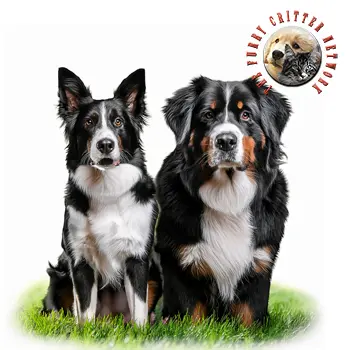Behavior
The breed standard for the Bernese mountain dog states that dogs should not be "aggressive, anxious or distinctly shy", but rather should be "good-natured", "self-assured", "placid towards strangers", and "docile". It only attacks if really needed (its owner is getting attacked). The temperament of individual dogs may vary, and not all examples of the breed have been bred carefully to follow the standard. All large breed dogs should be well socialized when they are puppies, and given regular training and activities throughout their lives.
Bernese are outdoor dogs at heart, though well-behaved in the house; they need activity and exercise, but do not have a great deal of endurance. They can move with amazing bursts of speed for their size when motivated. If they are sound (no problems with their hips, elbows, or other joints), they enjoy hiking and generally stick close to their people. Not being given the adequate amount of exercise may lead to barking and misbehavior in the Bernese.
Bernese mountain dogs are a breed that generally does well with children, as they are very affectionate. They are patient dogs that take well to children climbing over them. Though they have great energy, a Bernese will also be happy with a calm evening.
Bernese work well with other pets and around strangers. They are excellent guardians. They tend to bond with one owner or family, and are somewhat aloof and standoffish towards strangers.
The Bernese's calm temperament makes them a natural for pulling small carts or wagons, a task they originally performed in Switzerland. With proper training they enjoy giving children rides in a cart or participating in a parade, such as the Conway, New Hampshire holiday parade. Regional Bernese clubs often offer carting workshops. Carting competitions are held for the breed.
On July 1, 2010, the Bernese Mountain Dog became eligible to compete in AKC Herding Events. Herding instincts and trainability can be measured at noncompetitive herding tests. Berners exhibiting basic herding instincts can be trained to compete in herding trials.
The Bernese Mountain Dog does not like to be locked up in a house. He loves wide open spaces and exercise. Weekly brushing is sufficient. They are not well fit for apartments.
Health
Cancer is the leading cause of death for dogs in general, but Bernese Mountain Dogs have a much higher rate of fatal cancer than other breeds; in both U.S./Canada and UK surveys, nearly half of Bernese Mountain Dogs die of cancer, compared to about 27% of all dogs. Bernese Mountain Dogs are killed by many types of cancer, including malignant histiocytosis, mast cell tumor, lymphosarcoma, fibrosarcoma, and osteosarcoma. Inherited medical problems that a Bernese Mountain Dog may face include malignant histiocytosis, hypomyelinogenesis, progressive retinal atrophy, and possibly cataracts and hypoadrenocorticism. The breed is also prone to histiocytic sarcoma, a cancer of the muscle tissue that is very aggressive, and hereditary eye diseases that are common among larger dogs. A four-year-old Bernese with lymphoma named Dylan was one of the first dogs to receive chemotherapy at the Virginia-Maryland Regional College of Veterinary Medicine, and it was successful.
Bernese Mountain Dogs have an unusually high mortality due to musculoskeletal causes. Arthritis, hip dysplasia, and cruciate ligament rupture were reported as the cause of death in 6% of Bernese Mountain Dogs in the UK study; for comparison, mortality due to musculoskeletal ailments was reported to be less than 2% for pure-bred dogs in general. Owners of Bernese Mountain Dogs are nearly three times as likely as owners of other breeds to report musculoskeletal problems in their dogs; the most commonly reported being cruciate ligament rupture, arthritis (especially in shoulders and elbows), hip dysplasia, and osteochondritis. The age at onset for musculoskeletal problems is also unusually low. In the U.S./Canada study, 11% of living dogs had arthritis at an average age of 4.3 years. Most other common, non-musculoskeletal morbidity issues strike Berners at rates similar to other breeds. Prospective Bernese Mountain Dog owners should be prepared to cope with a large dog that may have mobility problems at a young age. Options to help mobility-impaired dogs may include ramps for car or house access, lifting harnesses and slings, and dog wheelchairs (ex: Walkin' Wheels). Comfortable bedding may help alleviate joint pain. Due to these common medical issues, owners of Bernese Mountain Dogs should make sure that their dogs receive OFA and CERF certificates.
The Bernese is one of the shortest-lived dog breeds, compared both to other breeds of a similar size and to purebred dogs in general. The average life expectancy of a Bernese Mountain Dog is approximately 7 to 9 years. Most other breeds of a similar size have median longevities of 10–11 years. In a 2004 UK survey, the longest-lived of 394 deceased Bernese Mountain Dogs died at the age of 15.2 years.






